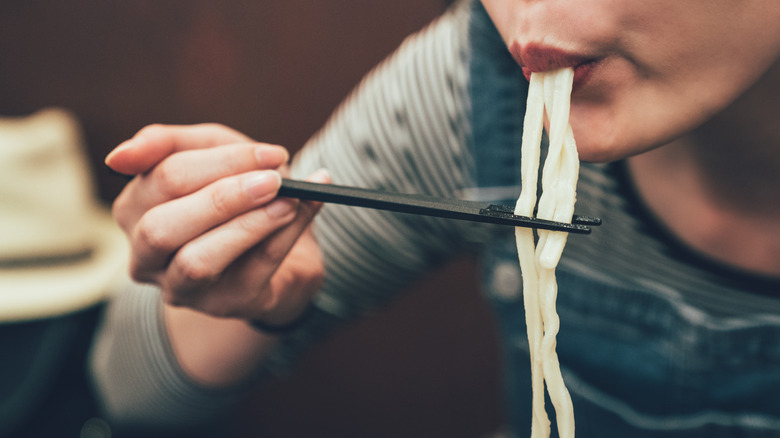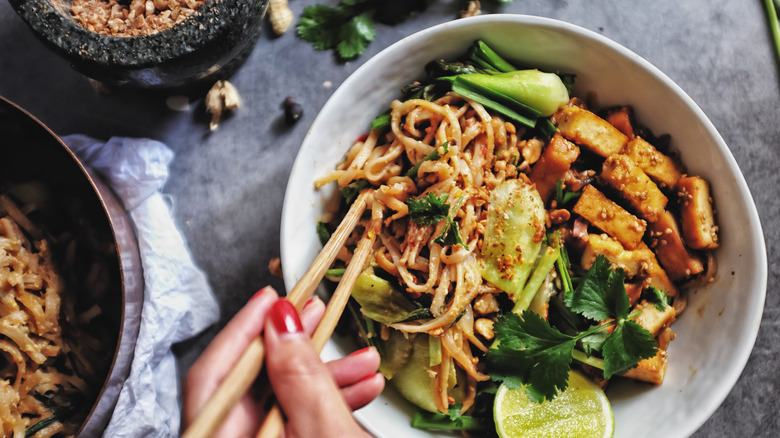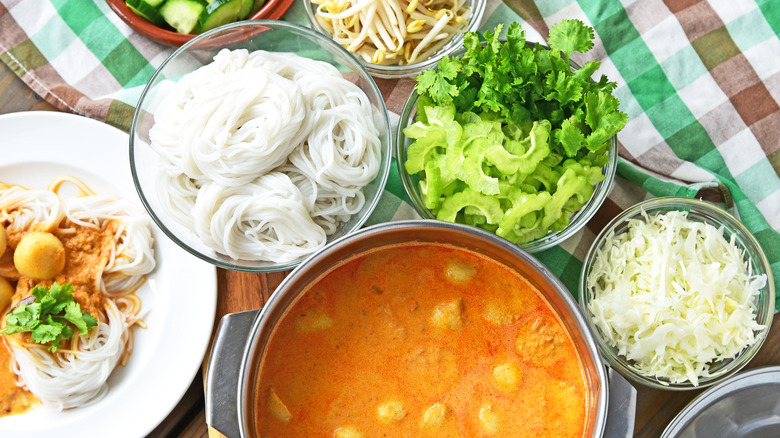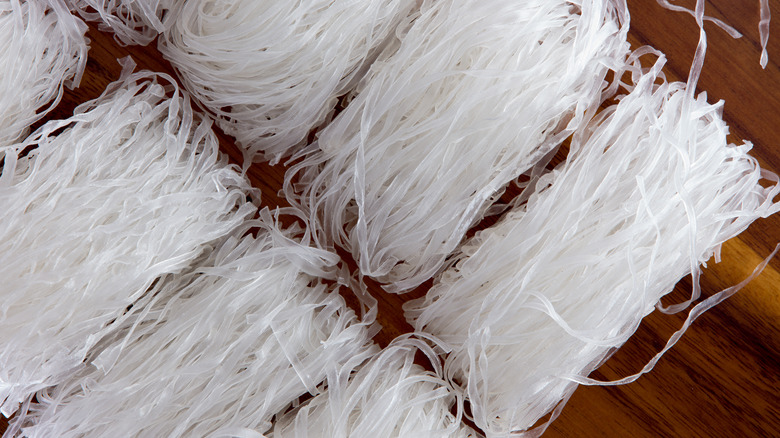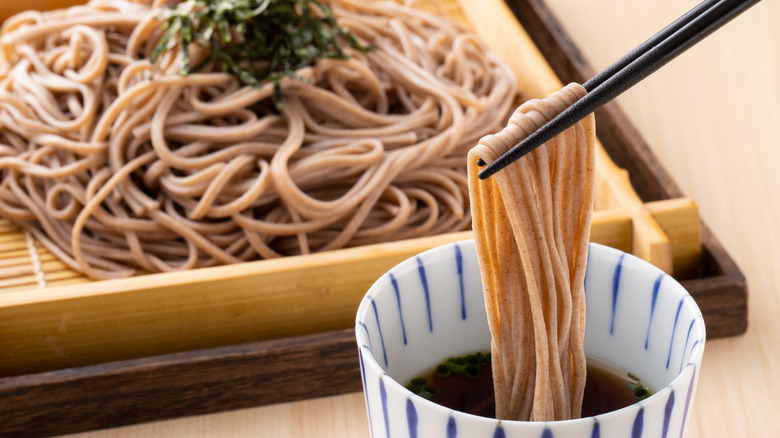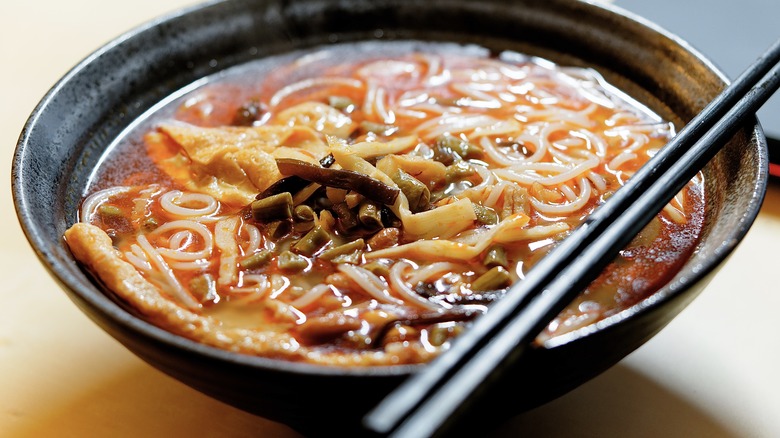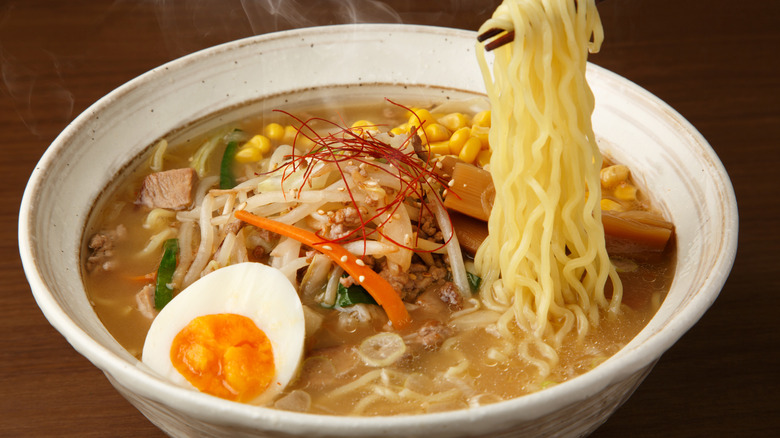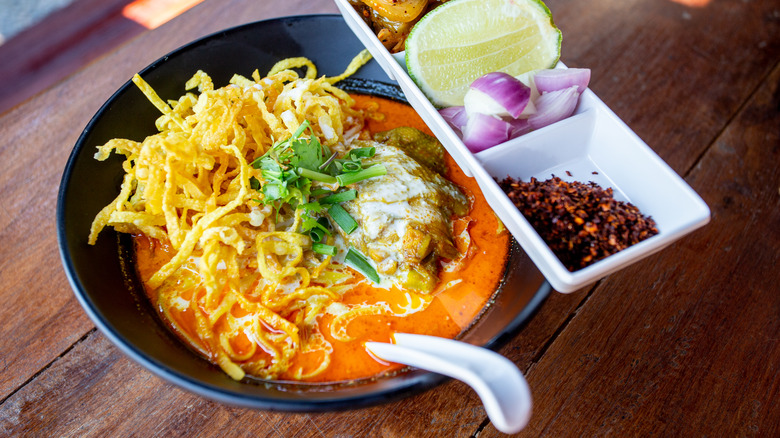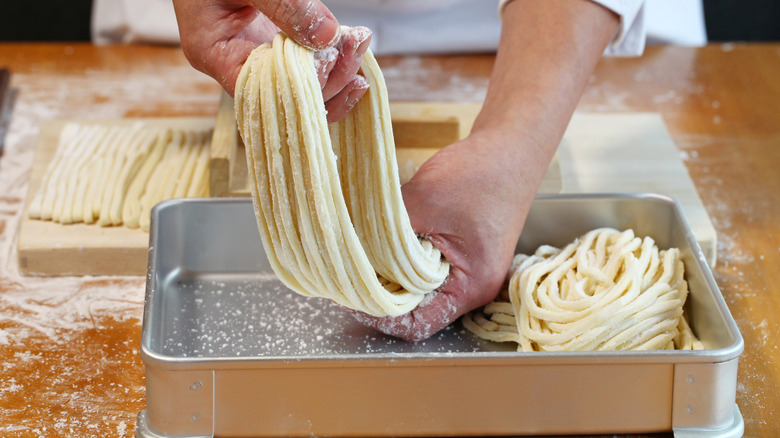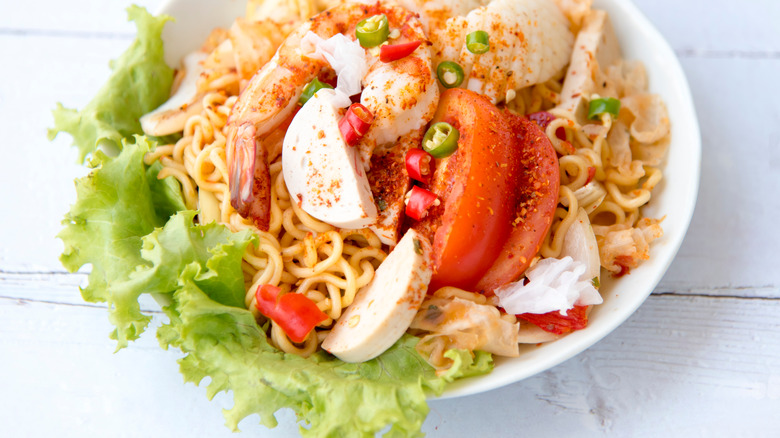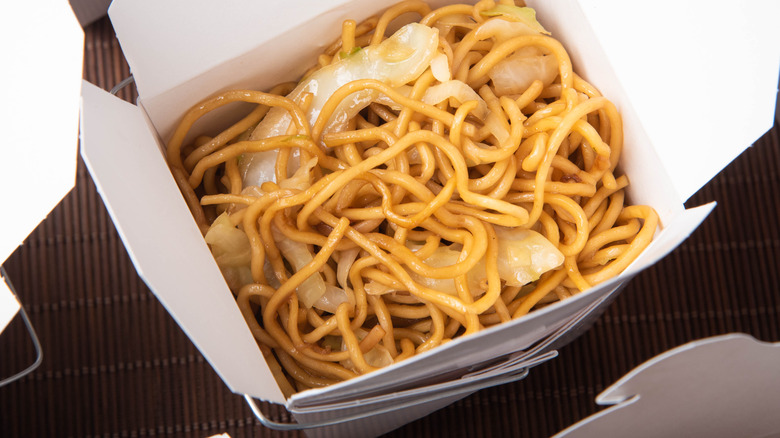Different Types Of Asian Noodles And How To Use Them
Think of noodles and you will undoubtedly think of Asia, of soups and stir-fries, and classic dishes from Japan, China, and Thailand. Noodles are part of Asia's rich cultural heritage and these countries have made their own traditional noodle dishes. What makes Asian noodles so ubiquitous and has given them such longevity, having been used in cooking over many years, is that they are incredibly versatile. Made from simple ingredients, noodles complement many dishes and soak up the taste of ingredients such as ginger and garlic.
Noodles originated in China and one of the earliest discoveries was a millet-based noodle around 4,000 years old. There are many customs when it comes to making noodles too, from stretching the dough a certain number of times, to hand-pulling it and leaving it hanging to dry. There is an art to noodle-making with talented chefs honing their skills over years. Not only that, but they're important not just to the cuisine of Asia, but also relevant to cultural celebrations such as birthdays, rituals, and customs. Cooking with noodles can be fun, and there are lots of quick and easy noodle recipes to try at home. However, what's vital is to understand the different types of Asian noodles and how to use them, so that you know the difference between rice noodles and egg noodles, as well as soba, udon, and ramen and the different dishes they are used in.
Rice noodles
There are many different types of rice noodles from the thinnest, most brittle dried varieties to flat and wide, with rounded and sticky varieties too. They are made with rice, and sometimes tapioca and cornstarch are added (via Pinkvilla). In Thailand, a classic noodle dish is Pad Thai which is made with rice stick noodles. According to The South China Morning Post, the history behind this recipe is connected with rice shortages during World War II, when eating rice noodles rather than rice was being encouraged, leading to the traditional sen chan noodles being created (per Expique). A Thai rice noodle snack, mee krob is deep fried noodles served with a tangy sauce that has a sweet flavor too. Meanwhile, ho fun Cantonese noodles, which are called sen yai in Thai, are large and come in flat strips that have been cooked and oiled so that they don't stick together. A classic dish using these rice noodles is called drunken noodles, although there's no alcohol involved.
Other types of rice noodles are called sen lek and sen mee noodles in Thailand and are much thinner, resembling linguine and angel hair pasta. There are lots of different recipes using rice noodles, and because these noodles are quite starchy, it's a good idea when cooking them to make sure that the noodles don't clump together. Because they're less dense than some noodle varieties, they don't need as much cooking as wheat-based noodles and a soup poured over them will cook them pretty quickly.
Fermented Thai noodles
Kanom jeen is a popular street food and roadside dish in Thailand. Originating from the Mon people in Southeast Asia, the white rice noodles are fermented overnight, using water and yeast, giving the noodles a subtle sour taste. They are served cold with a variety of different kanom jeen hot curries over the top, which range in terms of heat. A classic curry to serve with these noodles is nam ya with lots of incredible Asian ingredients. This is a fish curry made with coconut milk with ginger, lemongrass, and garlic added. A lighter, sweeter curry with fish balls is a popular kanom jeen dish, as is a coconut milk and sweet chili paste with shrimp known as nam prik. Other kanom jeen favorites include green curry and a hot Southern curry made with fish entrails.
Part of the kanom jeen experience is adding extra ingredients which are integral to the dish. Once the hot curry has been spooned onto the noodles, beansprouts and pickled vegetables, plus long beans, herbs and chopped-up cabbage can be added according to taste. Stink beans can also be added which are also called bitter beans which come in long, bright green pods and are packed with nutrients. The flavor of the noodles cuts through the other flavors, while the soft, silky texture is a great contrast with the crunchy additions and a wonderful alternative to the well-known Thai green curry with rice which is one of Thailand's much-loved dishes.
Glass noodles
Glass noodles are also called cellophane noodles and the names come from the fact that when cooked, they turn transparent. They start off dried and look like wiry thread. These noodles need to be soaked in water before being cooked so that they become soft. They are different than similar-looking rice noodles that turn white when cooked rather than see-through. Glass noodles are often made from ground mung beans, which means that they're a really great gluten-free noodle because they don't contain any grain at all (via Delighted Cooking). The noodles can also be made from sweet potato, as well as arrowroot and tapioca starch. These bean threads, or vermicelli as they are called in Chinese cuisine, soak up flavor rather than add any particular taste to a dish.
They are thrown in soups and hot pots, as well as being used in Asian stir-fry dishes, and they are also used in some varieties of Thai spring rolls. Other popular dishes include glass noodles and crab or glass noodles and prawns, cooked in a pot on a stove. They are also used to make a glass noodle salad (yum sen lon), which is a hot dish with different versions found in Laos.
Soba noodles
Traditional Japanese soba noodles are made from buckwheat, which may suggest they contain gluten, but they're actually gluten-free. However, some varieties do add wheat into the mix too, which those with food intolerances need to be aware of, while buckwheat itself is a known allergen for some people. Soba noodles can be eaten hot or cold, with so many different ways to serve them. One idea is a stir-fry such as a spicy peanut soba noodle bowl recipe or perhaps soba noodles with mushrooms and broccolini. Dishes served cold are varied too, with a peanut soba noodle salad, while soba noodles, which look like long pieces of brown spaghetti, have a nutty, strong flavor (via Insider).
There is a definitive way to eat soba noodles, which involves slurping them up rather than chewing them, with any noises being a positive sign that you're enjoying them. Eaten cold, soba noodles are great when they are dipped into a tsuyu sauce in which you can add whatever condiments you like, such as green onions and wasabi.
After all the noodles are finished, you may want to enjoy some sobayu. As explained by Global Kitchen, the water that the soba noodles are cooked in is served up in a cup and enjoyed warm. This adds a fun, quirky experience to the ritual of eating noodles Japan-style. Not only that, but the potassium-rich brew, which is also packed with nutrients and vitamin B is regarded as healthy.
Luosifen noodles
Perhaps one of the strangest noodles, but also one of the most loved in China, are luosifen river snail rice noodles. Known as the durian of noodles because of their strong odor, they are a specialty of China's Liuzho Province. The pungent scent comes from fermented bamboo shoots, giving the noodles that are served in a soup a sour aroma and taste. Meanwhile, there aren't any actual snails in the soup, but they are used to make the broth, adding to luosifen's distinct taste (via CNN). Such is the strength of the noodle soup that a South China Morning Post article reported on a Beijing Evening News report about a person in Italy calling the police about a possible bioweapon, when a neighboring Chinese student was unknowingly cooking luosifen.
President of China, Xi Jinping created a viral stir after visiting a luosifen processing plant in the region, and praising the industry. Whether the leader ate the noodles or not, the trip sparked interest among citizens, sharing their own recipes. Meanwhile, in a China News Service poll of 56,0000 participants, over half stated they'd miss the stinky noodles if they'd not eaten them for a few days (via Global Times). Renowned Chinese YouTube vlogger Li Ziqi who makes traditional food recipes from her rural home posted a video on how to make luosifen that has so far been viewed over an astonishing 70 million times, showing just how popular these noodles are.
Ramen noodles
Ramen is an incredible soup and what makes this Japanese broth so delicious are the soft, yet firm yellow ramen noodles. These are not just any noodle, but specific to this dish, and are actually Chinese in origin and made from wheat. One important ingredient is kansui which is an alkaline salt made from potassium carbonate and sodium bicarbonate, which gives the noodles their distinctive golden hue and enhances the robust texture of the noodles as well. Chef Teiichi Sakurai has demonstrated how best to eat ramen, which involves slurping up the noodles and advises that however ramen is eaten it should be fast, as in within five minutes, so that the noodles don't soak up too much of the broth (via Eater).
Ramen noodles were given new meaning in the classic Japanese film "Tampopo" where life is explored through the connection between love and food, with perhaps, "no greater joy than consuming a glistening bowl of ramen" (via Far Out Magazine). What also adds to people's passion for ramen is the different broths served with the noodles from a thick, gravy-like tonkotsu, to a clear shoyu with pieces of seaweed, and miso (via Taste Mag). There are a variety of toppings, including roasted meat, hard-boiled egg halves, and beansprouts. There are also many different ramen spice combinations too which all create individual broths, such as ginger, cayenne, and pepper, as well as garlic and herbs too.
Egg noodles
Yellow egg noodles are similar to pasta used in Italian recipes, except they have to be made using eggs, hence the name, as well as wheat flour. They are high in protein, while being low in cholesterol and carbohydrates. They soak up liquids well and this, along with the firmness of the noodles makes them a perfect addition to a stir-fry as well as a classic egg noodle soup.
Egg noodles are a main ingredient in the yellow, curry flavor of Khao soi, from the north of Thailand, which is a favorite on the menus of plenty of Asian restaurants. This dish includes meat that has been braised, quite often chicken drumsticks, so that it is melt-in-the-mouth, with a sauce made from coconut milk, and, of course, egg noodles. Curry paste and turmeric give the whole dish a yellow-orange hue, while other ingredients are added such as soy sauce. Pickled vegetables can be added at the table, along with shallots and lime. Meanwhile, a few fried noodles can top this dish to give it some crunch too.
One variety of egg noodle is the wonton noodle which is thin and "springy" after cooking which means that it isn't too soft after cooking and has some bite to it. These types of noodles are also great in a stir-fry and soups or served dry. Sometimes wonton egg noodles are served with actual wontons, whether steamed or fried, as well as charsu which is also added to ramen soups too.
Udon noodles
Just like soba noodles, udon noodles are Japanese, yet they are different. Udon noodles are made from wheat flour and are thick and long, with a firm texture that means they have some real substance to them and are chewier than many other noodles. They're the Japanese noodle version of comfort food and certainly look filling. One of the classic ways to serve these noodles is in a broth that is made from dashi which is seaweed- and fish-based. While soba noodles are fairly thick, udon is even fatter and is often rounded. Teuchi udon noodles, however are square in shape and flat, and are a favorite in Japan's Shikoku region.
The kneading process is really important to create just the right texture and springiness to the udon noodle and an interesting cultural tradition is to make the noodles using the feet! The dough is wrapped and stomped on to make the process less arduous. Udon noodles can be served cold with a dipping sauce, just like soba noodles. However, there are many dishes in which udon noodles are hot too, such as a hot-pot-style udon-suki made with sweet and savory miso. Meanwhile, yaki-udon is made by stir-frying udon noodles and adding a sauce made from soy, plus lot s of different ingredients. A curry udon is a real winter warmer with noodles served in a bowl of curry sauce that can range from mild to hot, depending on personal taste.
Instant noodles
While instant noodles may seem a little incongruous against the many different types of Asian noodles that have been made for centuries, the fact is that they have their own well-established culinary category. There is a fun side to instant noodles too, with a fascinating array of flavors that push noodle-eating into new realms, such as the Nissin brand of hot varieties such as Volcanic Mongolian Beef. The different flavors of instant noodles go beyond Asian culinary tradition too, with a good example being Knorr's pizza-flavored noodles. Other varieties include Tiger Brand's onion-flavored rice noodles.
Vietnamese businessman Pham Nhat Vuong, who in 2022 Forbes reported had a net worth of $6.5 billion, made his fortune by setting up an instant noodle business. Whilst studying abroad, he imported instant ramen noodles to Ukraine, making him Vietnam's first billionaire and creating the foundation for what was to become the largest privately-owned company in the country, Vingroup. (via Financial Times).
Meanwhile, in Thailand and renowned in countries across Asia and beyond, are Mama noodles with an incredible array of flavors from classic tom yum to green curry. Such is the popularity of Mama noodles that sales are around $300 million per year. A street-side dish served in Thailand is yum Mama, which is a sweet, spicy, and sour salad dish served hot with Mama noodles added. The ingredients are added to hot water before being tossed in sugar and chili, with onions and tomatoes added at the end.
Lo-mein and chow-mein noodles
Most people have heard of a chow mein, which is a Chinese sir-try dish with different recipe variations that are quick to make. A similar dish is lo mein, which again, can be made using different ingredients, such as a vegetable lo mein to a beef and broccoli lo mein. Both are egg noodles, and the chow mein variety is often referred to as Hong Kong noodles and are thin and partially cooked in water so that they can be simply added to a stir-fry where they quickly cook with a sauce. Another option is to instead fry the chow mein noodles in some oil to make them a little crunchier, and create a noodle pancake, adding the sauce and any other ingredients such as meat and vegetables on top.
Lo mein are a thicker variety than chow mein, and this gives them a denser quality so that they can withstand reheating and also sit for longer in a sauce. They are ideal for dishes with a heavier or richer sauce and take a few minutes to cook in boiling water. Because chow mein are potentially crispier, or not as soft as lo mein, they are often used in dishes with a little sauce rather than one where the sauce is much more of a main ingredient. An alternative to these specific noodles, is to use wonton noodles instead, which are similar. Either way, these dishes are popular Chinese takeout orders.
